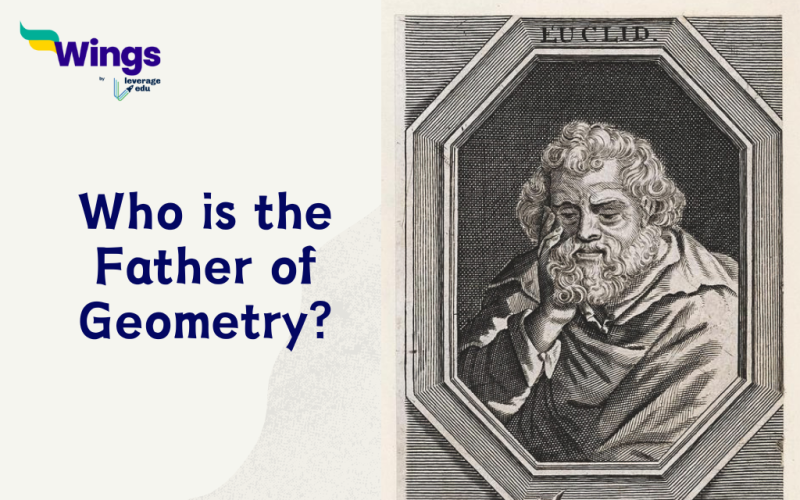Euclid is known as the father of Geometry. Euclid was a mathematician from ancient Greece, also known as Euclid of Alexandria, the father of Geometry or the founder of Geometry. His achievement, “Elements,” a compilation of geometric theorems, has been integral to the history of mathematics. His contributions also can be seen in number theory, perspective, mathematical precision, conic sections and spherical geometry. Let us get to know more about who is the father of Geometry along with some of his great contributions.
Table of Contents
Euclid: The Father of Geometry
Very little is known about Euclid, but we will answer why he is called the father of geometry in every sense. What is known of Euclid is from the philosopher commentator Proclus, who wrote about Euclid in his book “Commentary on the Element”.
- Euclid was a mathematician from Egypt who belonged to the Greek civilization.
- It is thought that he was born sometime around 300 BC in Alexandria, a Greek city, where he spent most of his years educating the youth in mathematics.
- It is believed he died at Alexandria, Egypt, circa 270 BC.
The name Euclid is a familiar figure to math students, appearing in textbooks, and the bulk of what is known about him centres on his mathematical achievements. Apart from maths, Euclid also is mentioned in subjects like the historical and scientific literature.
Also Read – Who Is The Father Of Mathematics?
“Elements” By Euclid
Euclid was a highly influential mathematician, who authored the groundbreaking theorems in his book called “Elements.” This book was a comprehensive work which consisted of topics related to mathematics like plane and solid geometry, proportions, 3D geometric figures and number theory.
- “Elements” presented various concepts and theorems of mathematics, many of which remain relevant today. Notably, Euclid’s use of logic in proofs significantly influenced Western philosophical thought.
- Although the origin of some ideas in “Elements” is debated, with some attributing them to earlier mathematicians like Pythagoras, Exodus, Theudis, etc. However, others believe his logics are justified and are his true opinions.
- The book “Elements” is a detailed 465 theorems with their corresponding proofs along with clear diagrams. This work also popularized a specific approach to geometry, now known as Euclidean geometry. Euclid also authored “Data,” a collection delving deeper into geometrical theorems and concepts. Similar to “Elements,” the attribution of authorship for “Data” remains under discussion.
Euclid’s “Elements” is considered an important source of geometric knowledge. The first printed edition appeared in 1482, in Venice. This 2,000-year-old work forms the very basic understanding of geometrical education, thus, Euclid’s title as the “Father of Geometry” is justified.
Also Read – Who Is The Father Of Computer?
Contribution and Achievements of Euclid
Despite the important ideas Euclid introduced, his renowned work ‘Elements,’ featured general axioms and five geometric postulates that act as a foundation for mathematical proofs, enabling the derivation of theorems through logical inferences from basic premises even today. Sir Thomas Heath again outlined, Euclid’s axioms and postulates in his 1908 book, “The Elements of Euclid.”
Euclid’s General Axioms are as follows:
- Things which are equal to the same thing are equal to one another.
- If equals are added to equals, the wholes are equal.
- If equals are subtracted from equals, the remainders are equal.
- Things which coincide with one another are equal to one another.
- The whole is greater than the part.
- Things which are double of the same things are equal to one another.
- Things which are halves of the same thing are equal to one another.
Euclid’s Five Postulates are –
- A straight line may be drawn from any one point to any other point.
- A terminated line can be produced indefinitely
- A circle can be drawn with any centre and any radius.
- All right angles are equal to one another.
- If a straight line falling on two straight lines makes the interior angles on the same side of it taken together less than two right angles, then the two straight lines, if produced indefinitely, meet on that side on which the sum of angles is less than two right angles.
These general axioms and postulates continue to be applied even today to prove geometrical theorems and solve geometric problems. The theorems, concepts and definitions of mathematics have helped students form the basic knowledge of Geometry which in turn also helps in solving problems related to advanced mathematics.
FAQ’s
Euclid, a mathematician from ancient Greece, specialized in geometry and logic. He is often referred to as the “father of geometry” and is best remembered for his work, the Elements, which laid down the basic principles of geometry that were widely accepted until the early 1800s.
Aryabhatta is the father of Math in India.
Euclid (c. 325-265 BC), hailing from Alexandria, likely attended the Academy established by Plato, and authored a work in 13 books (chapters) called The Elements of Geometry. In this treatise, he introduced geometry in a perfect axiomatic structure, which eventually became known as Euclidean geometry.
Relevant Blogs
That is all about who is the father of Geometry. If you want to know more about topics like this, then visit our general knowledge page!
 One app for all your study abroad needs
One app for all your study abroad needs













